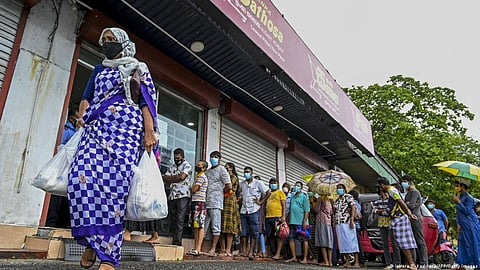

Many of Sri Lanka’s 22 million people are facing acute shortages of food, fuel and medicine as the island nation finds itself battling one of the worst economic crises since it became independent in 1948.
The economy got battered by the Covid pandemic which wrecked the tourism industry — a key revenue generator for the country — and hit other major sectors as well as foreign remittances.
At the same time, the government piled up a mountain of debt by borrowing heavily from foreign investors and countries. It also implemented badly timed tax cuts and temporarily banned the import of chemical fertilisers in a bid to encourage organic farming, a move that backfired as farmers were unable to cultivate enough crops, leading to the food shortages.
The heavy debt burden and eroding foreign exchange reserves have triggered a balance of payments crisis, making it tough to finance essential imports like vital drugs.
The worst part is the non-availability of medicines, said Jaya Kannika, a mother of three. Her mother, who is suffering from diabetes, does not have enough medication to keep her blood sugar level under control.
“When we went for a health check-up three months back, they gave some medicines to my mother and told her to take them only if it was necessary as they didn’t have enough medicines in stock,” Kannika told DW.
“When I felt sick last week, I did not go to the hospital as I know that they won’t treat me,” she added.
The vast majority of Sri Lankans cannot afford treatment in private hospitals and instead rely on the universal government health system.
But with shortages of vital drugs and cancellation of surgeries, the system is close to collapse, hitting common people hard.
Sri Lanka’s consumer price inflation — already at 30% — is expected to accelerate to 46% in the third quarter, according to Bloomberg Intelligence.
Surging food prices have also forced people like Baakiyam, a 71-year-old who lives alone in Nuwara Eliya district in the nation’s Central Province, to go hungry.
“I used to work as a daily-wage worker. But now there is not much work. Sometimes I eat, sometimes I do not. I cannot afford to buy much.”
The skyrocketing inflation, shortages of essential items and lengthy power blackouts have stoked public fury targeted at the government led by President Gotabaya Rajapaksa and his influential family.
Clashes broke out between government supporters and opponents this week, killing several people, including a member of parliament from the ruling Sri Lanka People’s Front party (SLPP), and injuring hundreds.
After the violence erupted, Prime Minister Mahinda Rajapaksa — the president’s elder brother — resigned and took shelter in a naval base.
To control the situation, the government has imposed a state of emergency and curfews, in addition to granting sweeping powers to the military and the police, including orders to shoot looters on sight.
Security forces patrolling in armoured personnel carriers appear to have largely restored order, but the situation remains tense across the country.
President Gotabaya has defied calls to resign, pledging instead to form a unity government. But the opposition has so far refused to join and called for clipping the powers of the presidency.
Sri Lanka has $8.6 billion of debt due this year and Colombo needs to strike a deal with creditors and the International Monetary Fund to stabilise its finances and end the crippling shortages of essential goods.
Visit news.dtnext.in to explore our interactive epaper!
Download the DT Next app for more exciting features!
Click here for iOS
Click here for Android